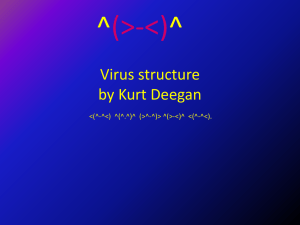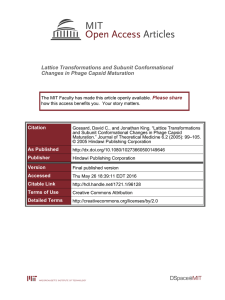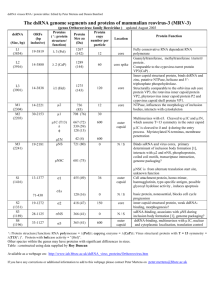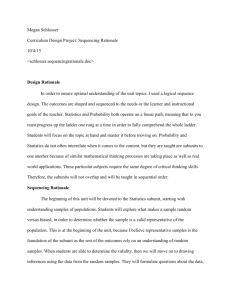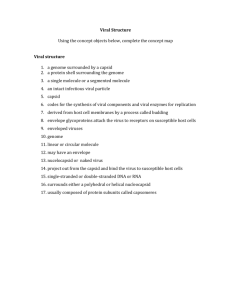Lattice transformations and subunit conformational changes in phage capsid maturation
advertisement
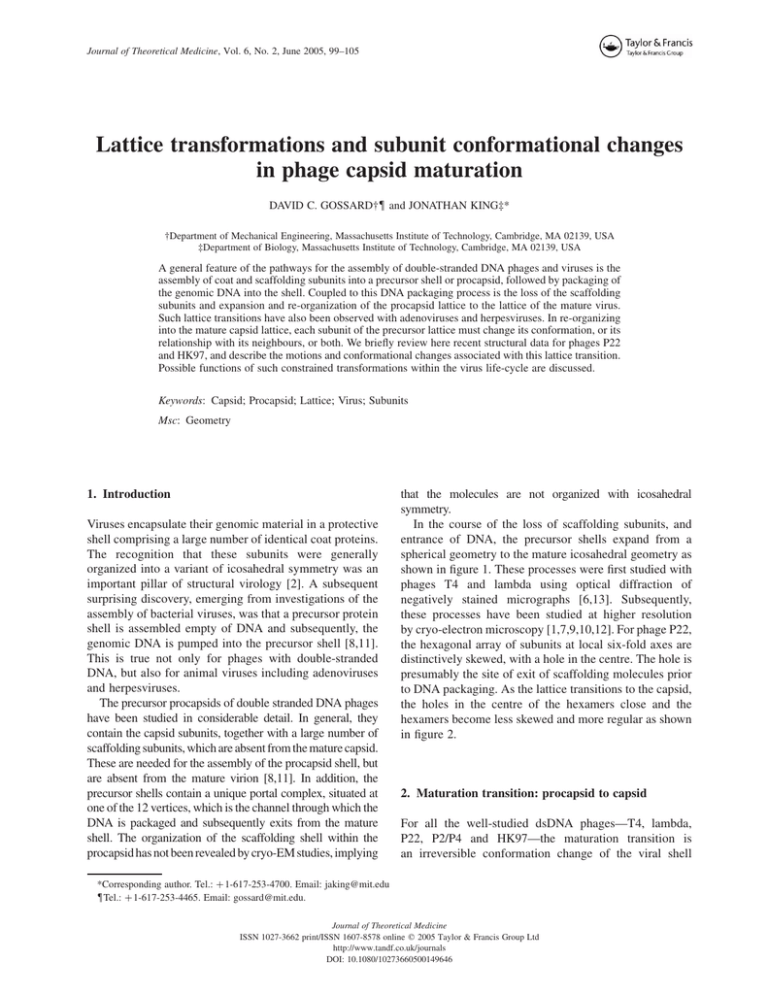
Journal of Theoretical Medicine, Vol. 6, No. 2, June 2005, 99–105
Lattice transformations and subunit conformational changes
in phage capsid maturation
DAVID C. GOSSARD†{ and JONATHAN KING‡*
†Department of Mechanical Engineering, Massachusetts Institute of Technology, Cambridge, MA 02139, USA
‡Department of Biology, Massachusetts Institute of Technology, Cambridge, MA 02139, USA
A general feature of the pathways for the assembly of double-stranded DNA phages and viruses is the
assembly of coat and scaffolding subunits into a precursor shell or procapsid, followed by packaging of
the genomic DNA into the shell. Coupled to this DNA packaging process is the loss of the scaffolding
subunits and expansion and re-organization of the procapsid lattice to the lattice of the mature virus.
Such lattice transitions have also been observed with adenoviruses and herpesviruses. In re-organizing
into the mature capsid lattice, each subunit of the precursor lattice must change its conformation, or its
relationship with its neighbours, or both. We briefly review here recent structural data for phages P22
and HK97, and describe the motions and conformational changes associated with this lattice transition.
Possible functions of such constrained transformations within the virus life-cycle are discussed.
Keywords: Capsid; Procapsid; Lattice; Virus; Subunits
Msc: Geometry
1. Introduction
Viruses encapsulate their genomic material in a protective
shell comprising a large number of identical coat proteins.
The recognition that these subunits were generally
organized into a variant of icosahedral symmetry was an
important pillar of structural virology [2]. A subsequent
surprising discovery, emerging from investigations of the
assembly of bacterial viruses, was that a precursor protein
shell is assembled empty of DNA and subsequently, the
genomic DNA is pumped into the precursor shell [8,11].
This is true not only for phages with double-stranded
DNA, but also for animal viruses including adenoviruses
and herpesviruses.
The precursor procapsids of double stranded DNA phages
have been studied in considerable detail. In general, they
contain the capsid subunits, together with a large number of
scaffolding subunits, which are absent from the mature capsid.
These are needed for the assembly of the procapsid shell, but
are absent from the mature virion [8,11]. In addition, the
precursor shells contain a unique portal complex, situated at
one of the 12 vertices, which is the channel through which the
DNA is packaged and subsequently exits from the mature
shell. The organization of the scaffolding shell within the
procapsid has not been revealed by cryo-EM studies, implying
that the molecules are not organized with icosahedral
symmetry.
In the course of the loss of scaffolding subunits, and
entrance of DNA, the precursor shells expand from a
spherical geometry to the mature icosahedral geometry as
shown in figure 1. These processes were first studied with
phages T4 and lambda using optical diffraction of
negatively stained micrographs [6,13]. Subsequently,
these processes have been studied at higher resolution
by cryo-electron microscopy [1,7,9,10,12]. For phage P22,
the hexagonal array of subunits at local six-fold axes are
distinctively skewed, with a hole in the centre. The hole is
presumably the site of exit of scaffolding molecules prior
to DNA packaging. As the lattice transitions to the capsid,
the holes in the centre of the hexamers close and the
hexamers become less skewed and more regular as shown
in figure 2.
2. Maturation transition: procapsid to capsid
For all the well-studied dsDNA phages—T4, lambda,
P22, P2/P4 and HK97—the maturation transition is
an irreversible conformation change of the viral shell
*Corresponding author. Tel.: þ 1-617-253-4700. Email: jaking@mit.edu
{Tel.: þ1-617-253-4465. Email: gossard@mit.edu.
Journal of Theoretical Medicine
ISSN 1027-3662 print/ISSN 1607-8578 online q 2005 Taylor & Francis Group Ltd
http://www.tandf.co.uk/journals
DOI: 10.1080/10273660500149646
100
D.C. Gossard and J. King
Figure 1. Cryo-EM images of P22 procapsid and capsid are on the left and right, respectively. The 5-fold, 3-fold and 2-fold axes of symmetry are
highlighted. Coat proteins making up the asymmetric unit are shown in colour. From [7].
characterized by an increase in radius and a more
polyhedral appearance as shown in figure 1. In fact,
studies of the transition by calorimetry reveal that the
procapsid is in a metastable higher energy state, and the
transition to the mature lattice is exothermic [5]. Though
the procapsid-to-capsid transitions have been well
described, structural data has been limited to the medium
resolution obtainable from cryo-electron microscopy.
However, the structure of one dsDNA phage, Hong
Kong 97 of E. coli has been crystallized and the capsid
subunits structure determined to high resolution by [14].
The HK97 viral capsid comprises 420 sub-units in a T ¼ 7
packing arrangement. The structure of the HK97 capsid is
unusual (perhaps unique) in that its coat protein chains are
intertwined and cross-linked in a so-called “chain-mail”
topology as shown in figure 3.
3. Analysis and data
One major question concerns whether the lattice
transformation is associated with a change in subunit
conformation or a change in the contacts between
subunits. Coat protein subunits of P22 and HK97 provide
conflicting answers to this question. The coat proteins of
P22 and HK97 have less than 20% sequence identity, yet
Figure 2. Cryo-EM images of P22 procapsid and capsid showing
skewed hexamers becoming more regular during the maturation
transition. From [15].
they both contain three major helices that are aligned to a
surprising degree. Figure 4 shows the 3D structure of a
HK97 subunit superimposed on a cryo-EM image of a P22
subunit. Jiang et al. [7] have shown that the major helices
of P22 undergo significant movement during the
maturation transition as shown in figure 5. Whether the
major helices of HK97 undergo a similar motion has not
yet been unambiguously resolved [3].
Another important question concerns the extent to
which the coat proteins of viruses with more than 60
subunits must undergo a conformation change simply to
form a closed shell with icosahedral symmetry as quasiequivalence theory suggests. To obtain some quantitative
insight into this question the subunits of the HK97 capsid
were examined numerically. The asymmetric unit of
HK97 consists of 7 coat proteins labeled A – G, as is shown
in figure 6. The 5-fold axis of symmetry is located at the
apex of subunit G, at the top of the figure.
A ribbon diagram of one of the subunits is shown in
figure 7. The subunit consists of a central domain
containing three alpha helices, the largest of which is
designated “H1” here. Protruding from the central domain
are two extended arms. The first, designated “a”, is the Nterminus and the second, designated “b” is an extended
loop. Two additional regions, a loop near the apex, and
a nearby alpha helix, are designated “c” and “d”,
respectively.
We assumed that the major helix, H1, was relatively
rigid with respect to the remainder of the protein sub-unit.
Consequently, three alpha-carbons on H1 (residues 204,
222 and 210, respectively) were used to define a local
coordinate system on each subunit. The coordinate system
and the backbone of one of the subunits are shown in
figure 8.
Rigid-body transformations were applied to all seven
subunits so as to make the coordinate systems coincide
and therefore, superimpose the subunits to admit a visual
comparison of their conformations. Figure 9 shows this
superposition of the backbones of all seven subunits. This
figure gives a qualitative sense of the extent to which the
Phage capsid maturation
101
Figure 3. HK97 maturation transition. The image on the left is the procapsid. The image on the right is the capsid. Note the larger radius and more
angular shape of the capsid. From [3].
subunits’ conformations diverge from the single original
(pre-assembly) conformation.
To obtain a more quantitative understanding, the
coordinates of the alpha-carbons for the six subunits
forming the hexamers in the asymmetric unit were
averaged and used as a reference. Then for each subunit,
the “error” or “deviation” was defined as the Euclidean
distance between each alpha-carbon from the reference,
i.e. the hexameric average. This “deviation” was plotted as
a function of residue number, i.e. backbone length, for
each subunit as shown in figure 10.
It should be noted that the “deviations” found in this
way are all positive because only the distance between
each alpha-carbon and the reference was determined, i.e.
there is no sign information.
From figure 10, it can be seen that the maximum
deviation occurs at four points along the backbone of each
subunit. These are designated “a”, “b”, “c” and “d”,
respectively and can also be seen in figure 7. From figure
10, it can also be seen that the largest deviations occur at
positions “a” and “b” and on subunits G, A and B,
respectively. This is to be expected given the higher
curvature of the capsid shell near its 5-fold axes of
symmetry.
To better understand the collective motion of the HK97
subunits, a 3-D “disk” was superimposed on the major
helices of each subunit. The result is shown in figure 11.
The images on the upper left and upper right show the
relative orientation of the subunits of the HK97 procapsid.
The images on the lower left and lower right show the
relative orientation of the subunits of the HK97 capsid.
The skewed nature of the hexameric grouping in the
procapsid is readily apparent as is the more regular nature
of the hexameric group in the capsid. In the capsid, all
seven subunits of the asymmetric unit are extended and lie
essentially in the same plane. Consequently, the asymmetric unit covers a larger area that contributes both to the
larger radius and larger volume of the capsid shell.
Further, the planar shape of the asymmetric unit results in
the major curvature of the capsid shell lying at the
interfaces between asymmetric units. In the procapsid,
subunit G is tilted with respect to the hexameric group and
the subunits in the hexamer are rotated into a more
compact, less extended configuration. The asymmetric
group as a whole is smaller and more compact and the
curvature of the procapsid shell is distributed over the
asymmetric unit as well as at the interfaces between
asymmetric units.
Figure 4. Structure of HK97 subunit superimposed on cryo-EM image of P22 subunit. HK97 and P22 subunits both have three major helices and a
surprising degree of alignment despite having less than 20% sequence identity. From [7].
102
D.C. Gossard and J. King
Figure 5. Movement of P22 subunit helices during maturation transition. Light cylinders represent the location of P22 subunit helices in procapsid. Dark
cylinders represent the location of P22 subunit helices in the capsid. The image on the right is rotated 908 from the image on the left. From [7].
4. Conclusions and recommendations
The changes in subunit conformation associated with the
procapsid-to-capsid transformation are significant, but not
outside the range of protein motions observed for
polymerases, ATPases, and other protein complexes.
However, the changes discussed above are not occurring
free in solution, but within the capsid lattice. The collective
motion of a set of subunits involves both rotations and
translations as can be seen in figure 11. We do not yet
understand the coupling between the individual motions of
the subunits and the collective motions within the lattice.
5. Functions of the lattice transitions
Phages P22 and HK97 are not closely related, and the amino
acid sequences of their coat subunit polypeptide chains are not
obviously homologous though they have the same basic fold.
Yet they participate in a very similar rearrangement reaction in
the procapsid-to-capsid transition. This suggests a biologically conserved function. We suspect that the functions of this
transformation have to do with the properties and functions of
the inner surface of the capsid lattice. In the procapsid, sites
on the inner surface are occupied by scaffolding proteins.
When the scaffolding subunits exit, some parts of these sites
Figure 6. The asymmetric unit of the HK97 viral capsid (PDB ID:
1fh6). The “chain-mail topology” refers to the interlocking nature of the
subunits. The 5-fold axis of symmetry is located at the apex of subunit G.
may be available for contact with the entering DNA. In the
mature capsids of P22, Lambda, T4 and other phages, there is
no evidence that the packaged DNA is actually interacting
with the inner lattice of the capsid. However, that might not be
true when the first turns of DNA are pumped into the
procapsid, particularly if this takes place before the procapsidto-capsid lattice transition. Because of the stiffness of DNA,
the initial stretches of DNA injected would be expected to take
the maximal curvature allowed by the shell diameter
(,60 nm), and thus pack against the inside of the capsid [4].
The packed DNA appears to be organized as concentric
shells [15]. Specific binding interactions might be
important in organizing the initial coils of DNA. However,
such binding interactions, though helping to organize the
entering DNA, would interfere with the subsequent release
of packaged DNA and its injection into the host cell. In
this context, the role of the lattice transition is to terminate
transient interactions with the outer coils of DNA,
releasing the DNA within the inner volume of the capsid,
ready for release into the cell during DNA injection.
6. Initiation and propagation of the lattice transition
DNA enters the precursor shell through the portal complex. It
seems reasonable that events happening at this complex initiate
Figure 7. A ribbon diagram on a single coat protein of the HK97 viral
capsid (1fh6). The coat protein subunit consists of a central domain
containing three alpha-helices, the largest of which is designated “H1”
here. Protruding from the central domain are two extended arms. The
first, designated “a”, is near the N-terminus and the second, designated
“b”, is an extended loop. Two additional regions, a loop near the apex,
and a nearby alpha-helix, are designated “c” and “d”, respectively.
Phage capsid maturation
103
Figure 8. The backbone of a single coat protein of HK97 viral capsid.
Three alpha-carbons (residues 204, 222 and 210, respectively, designated
by small spheres) on the largest alpha-helix were used to define a local
coordinate system.
the procapsid to capsid transition. A considerable quantity of
ATP is hydrolyzed in this process and substantial mechanical
forces are generated. We envisage that the initiation of
pumping of the DNA into the procapsid is the stimulus that
starts the transition, which propagates from the portal vertex.
Analysis of the beginning and end states does not reveal the
pathway of the propagation of the lattice transition. It could
proceed helically around the lattice, one hexamer at a time. Or
alternately, it could proceed with five-fold symmetry, up all
five icosahedral faces, terminating at the vertex opposite to the
portal vertex. Sorting this out will require trapping
intermediates in the transition, which is feasible by cryo-EM.
Many steps in viral capsid assembly appear to proceed
independently of the cellular apparatus. These steps are
potential targets for antiviral drugs. Indeed the actual
inhibitory effectiveness of the anti-HIV protease follows
from the role of this protease in generating the nucleocapsid
Figure 9. Rigid-body transformations were applied so as to
superimpose the subunits to admit a visual comparison of their
conformations. This figure gives a qualitative sense of the extent to which
the subunits’ conformations diverge from the putative single original
(pre-assembly) conformation.
proteins. For viruses such as Herpes virus, the scaffolding is
removed by proteolytic functions, and is a possible target for
anti-virals. However other steps, such as DNA packaging, or
the essential capsid transitions discussed here, open up other
targets.
Acknowledgements
We thank Wah Chiu, Jack Johnson and Roger Hendrix for
valuable discussions and access to data, Chris Mitchell of
MIT for assistance in the modelling and Peter Weigele for
assistance with the manuscript.
Figure 10. The coordinates of the alpha-carbons for the 6 subunits forming the hexamer in the asymmetric unit were averaged (subunits A– F in figure
6). Then for each subunit, the “error” or “deviation” was defined as the Euclidean distance between each alpha-carbon from the reference, i.e. the
hexameric average. This “deviation” is plotted as a function of residue number, i.e. backbone length, for each subunit. The largest deviation occurs at 4
points along the backbone of each subunit. These are designated “a”, “b”, “c” and “d”, respectively. Their physical location on the subunit can be seen in
figure 2. The largest deviations occur on subunits G, A and B, respectively, and at positions “a” and “b”.
104
D.C. Gossard and J. King
Figure 11. Maturation transition of HK97 (1fh6). To facilitate visualization, 3D discs have been superimposed on the three major helices of the subunits.
Upper left: side view of procapsid. Upper right: front view of procapsid. Lower left: side view of the capsid. Lower right: front view of the capsid.
References
[1] Baker, T.S., Olsen, N.H. and Fuller, S.D., 1999, Adding the third
dimension to virus life cycles: three-dimensional reconstruction of
icosahedral viruses from cryo-electron micrographs. Microbiol.
Mol. Biol. Rev., 63, 862–922.
[2] Caspar, D.L.D. and Klug, A., 1962, Physical principles in the construction
of regular viruses. Cold Spring Harb. Symp. Quant. Biol., 27, 1–24.
[3] Conway, J.F., Wikoff, W.R., Cheng, N., Duda, R.L., Hendrix, R.W.,
Johnson, J.E. and Steven, A.C., 2001, Virus maturation involving
large subunit rotations and local refolding. Science, 292, 744– 748.
[4] Earnshaw, W.C., King, J., Harrison, S.C. and Eiserling, F.A., 1978,
The structural organization of DNA packaged within the heads of
T4 wild-type, isometric and giant bacteriophages. Cell, 14,
559–568.
[5] Galisteo, M.L. and King, J., 1993, Conformational transformations
in the protein lattice of phage P22 procapsids. Biophys. J., 65,
227–235.
[6] Horn, T., Wurtz, M. and Horn, B., 1976, Capsid transformation
during packaging of bacteriophage (DNA). Philos. Trans. R. Soc.
Lond. B. Biol. Sci., 276, 51 –61.
[7] Jiang, W., Li, Z., Zhang, Z., Baker, M.L., Prevelige, P.E., Jr. and
Chiu, W., 2003, Coat protein fold and maturation transition of
Phage capsid maturation
[8]
[9]
[10]
[11]
bacteriophage P22 seen at subnanometer resolutions. Nat. Struct.
Biol., 10, 131 –135.
King, J., Botstein, D., Casjens, S., Earnshaw, W., Harrison, S. and
Lenk, E. 1976, Structure and assembly of the capsid of
bacteriophage P22. Philos. Trans. R. Soc. Lond. B. Biol. Sci., 276,
37–49.
King, J. and Chiu, W., 1997, The procapsid to capsid transition in
double-stranded DNA bacteriophages. In: W. Chiu, R.M. Burnett
and R. Garcea (Eds) Structural Biology of Viruses (Oxford
University Press), pp. 288– 311.
Lata, R., Conway, J.F., Cheng, N., Duda, R.L., Hendrix, R.W.,
Wikoff, R.W., Johnson, J.E., Tsuruta, H. and Steven, A.C., 2000,
Maturation dynamics of a viral capsid: Visualization of transitional
intermediate states. Cell, 100, 253–263.
Prevelige, P.E., Thomas, D. and King, J., 1993, Nucleation and
growth phases in the polymerization of coat and scaffolding
[12]
[13]
[14]
[15]
105
subunits into icosahedral procapsid shells. Biophys. J., 64,
824–835.
Sun, Y., Parker, M., Weigele, P., Casjens, S., Prevelige, P.E. and
Krishna, N.R., 2000, Structure of the coat protein-binding domain
of the scaffolding protein from a double-stranded DNA virus. J. Mol.
Biol., 297, 1195–1202.
Wagner, J. and Laemmli, U.K., 1976, Studies on the maturation of
the head of bacteriophage T4. Philos. Trans. R. Soc. Lond. B. Biol.
Sci., 276, 15–26.
Wikoff, W.R., Liljas, L., Duda, R.L., Tsuruta, H., Hendrix, R.W.
and Johnson, J.E., 2000, Topologically linked protein rings in the
bacteriophage HK97 capsid. Science, 289, 2129–2133.
Zhang, Z., Greene, B., Thuman-Commike, P., Jakana, J., Prevelige,
P., King, J. and Chiu, W., 2000, Visualization of the maturation
transition in bacteriophage P22 electron cryomicroscopy. J. Mol
Biol., 297, 615–626.
